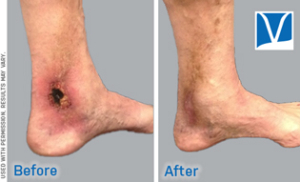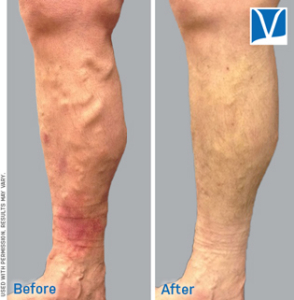Patients often ask if treating varicose vein skin changes is possible. The answer is yes. This problem is called stasis dermatitis or gravitational eczema.
 What starts as simple varicose veins can progress over time to swelling. Swelling leads to the skin changes. At first it may just be puffiness around the ankle at the end of the day. As time goes on, it may manifest as a line from a sock at the end of the day. This happens when the elastic of the sock bank compresses a strip of skin making an indentation in the swollen ankle.
What starts as simple varicose veins can progress over time to swelling. Swelling leads to the skin changes. At first it may just be puffiness around the ankle at the end of the day. As time goes on, it may manifest as a line from a sock at the end of the day. This happens when the elastic of the sock bank compresses a strip of skin making an indentation in the swollen ankle.
Over time some patients will get more and more swelling. This can eventually go to the knee and above. Usually the swelling improves at night.
Chronic Swelling Leads to Skin Damage by The Ankle
With the cycle of daily swelling the skin is stretched. This causes inflammation and damage to the skin. As the skin is stretched by daily swelling from the varicose veins the skin is irritated. At first it may appear red. With time it starts to get hard. Over time this hardness can manifest as brown skin by the ankles. Often this skin itches and can easily bleed when scratched. If wounds appear, they can be hard to heal.

Why does this happen?
Treatment Can Reverse This Cycle
In the old days, varicose veins requiring treatment were addressed in the operating room at a hospital in an operation called vein stripping. This was painful, took a lot of time to recover, and thus there was a lot of down time after where patients had to take time off work and heal. That has changed considerably.
Now there are no down-time options to treat varicose veins in the office setting under a local anesthesia. Endovenous Thermal Ablation is a treatment alternative to surgical stripping of varicose veins. This can be done with laser (known as endovenous laster therapy or EVLT), or radiofrequency ablation, such as Closurefast RFA. With ultrasound visualization thermal energy, or heat, is then delivered inside the vein, which causes the vein to collapse and seal shut. The procedure is typically done in the doctor’s office under local anesthesia.
Venaseal is the mostly recent vein closure technology. This technique uses an FDA approved specialty formulation of high grade medical cyanoacrylate-based adhesive with a catheter engineered to be inert to adhesive and a dispenser gun designed to deliver adhesive doses precisely.
The clinical results are equivalent to Closurefast RFA, and the procedure seems to have less discomfort than thermal based techniques such as RFA or EVLT. Sclerotherapy can also be used to treat both varicose and spider veins.
For any procedure, patients are able to walk immediately after and most individuals are able to return to work the next day.
Finding the right vein treatment option
If you are interested in learning more about varicose veins treatment options, simply fill out our Online Appointment Request Form or call any of our clinics in Northwest Portland , Tigard, Happy Valley, Hillsboro or Bend, Oregon.

